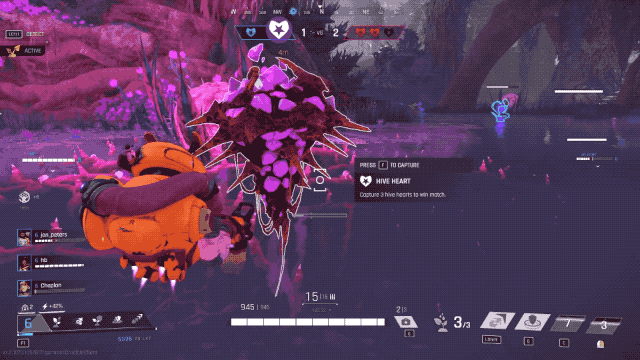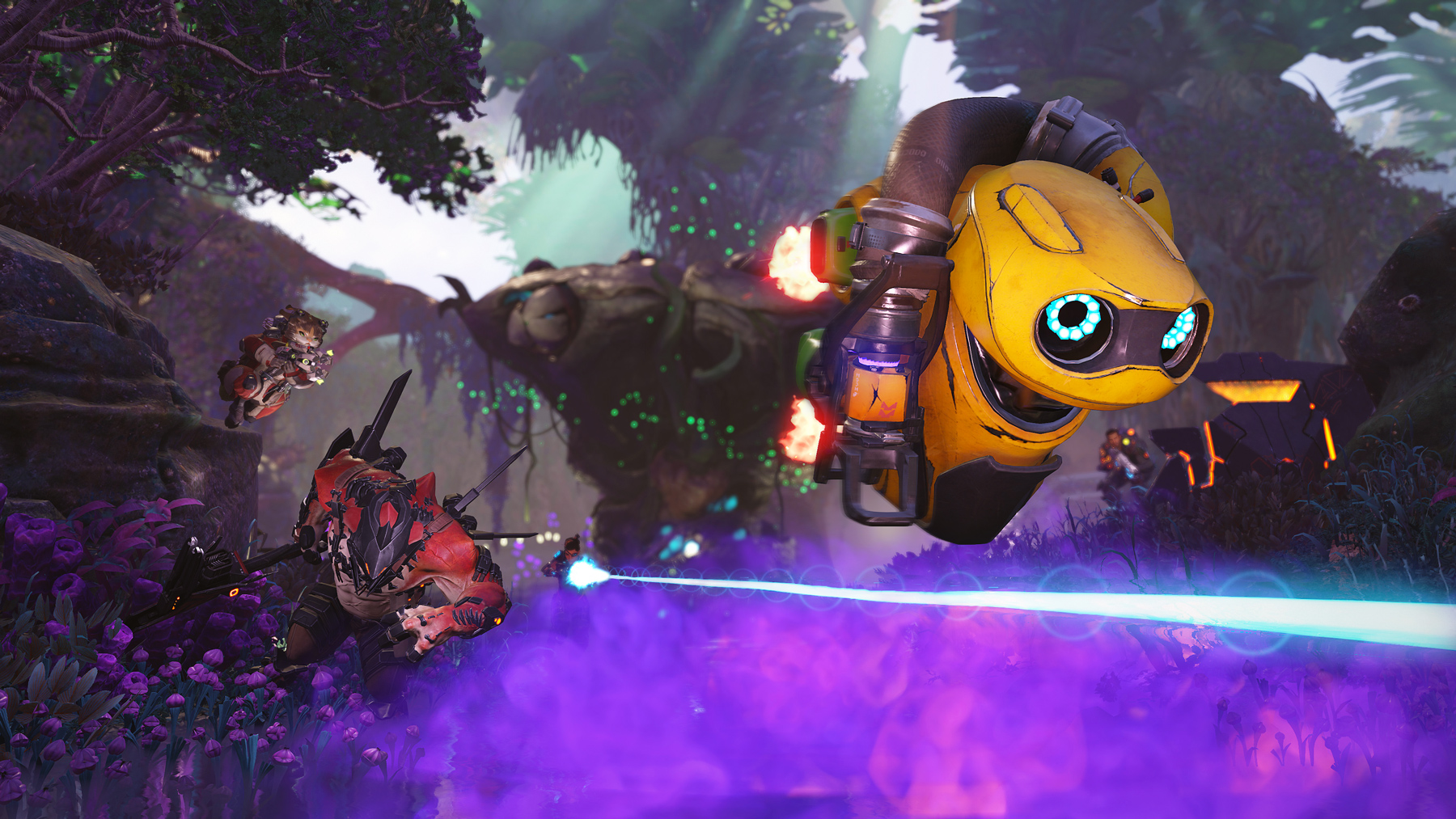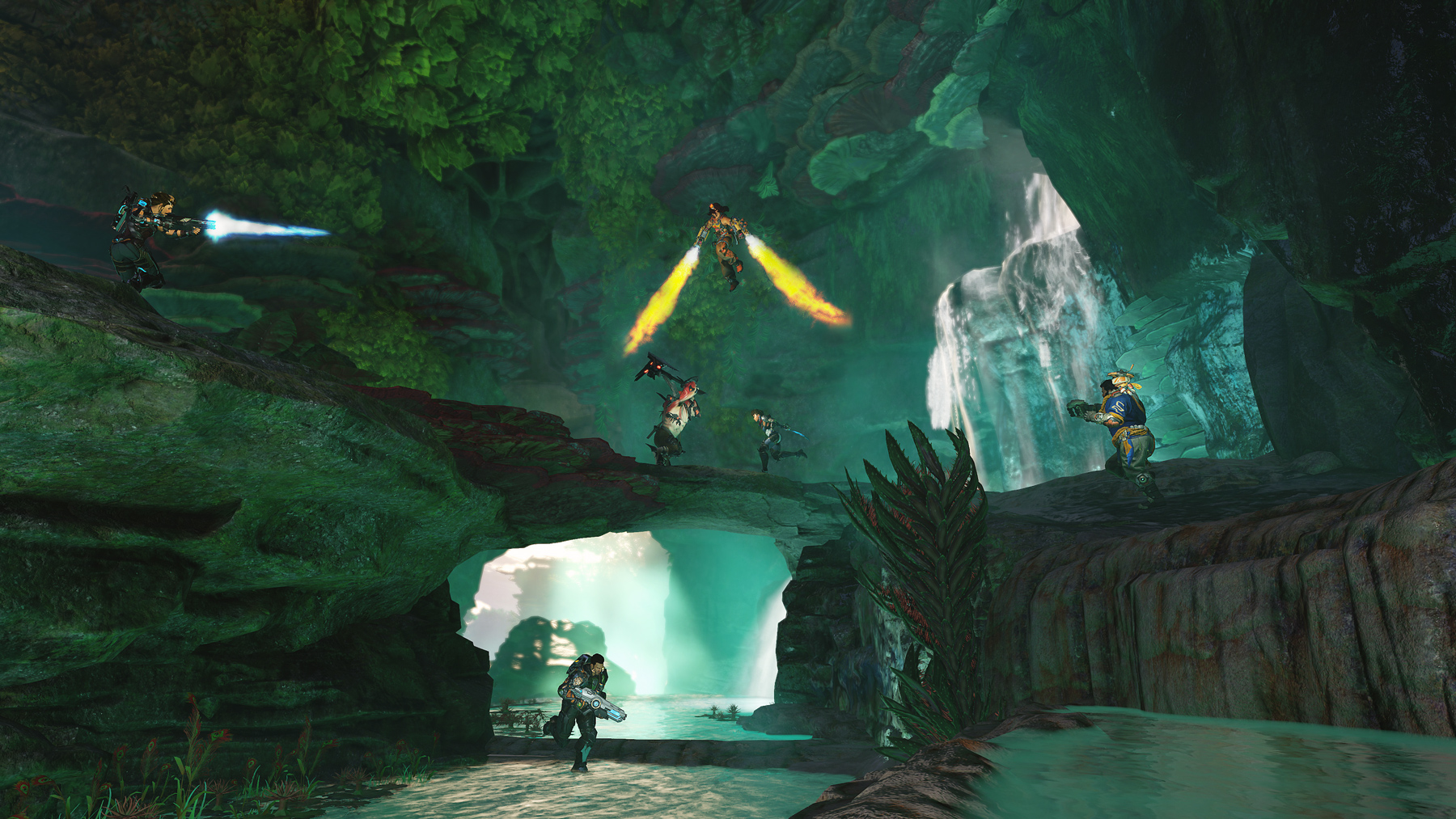‘Crucible’ proves that Amazon is finally serious about video games –
Amazon does seemingly everything. The e-commerce giant has a foothold in audiobooks, fresh groceries, Netflix-style video streaming and oh-so-much-more. It’s no surprise, therefore, that the company wants to widen its influence in the video game industry. The Jeff Bezos empire already owns Twitch, the biggest game live-streaming service, and supports developers with its CryEngine-based Lumberyard platform and AWS server infrastructure. But it’s never been a heavyweight game publisher. Multiplayer brawler Breakaway was canceled and The Grand Tour Game was a forgettable TV show tie-in.
A lot is riding on Crucible, then. The third-person online shooter is the first of two blockbuster titles scheduled to come out this year. (The other is New World, a subscription-free MMORPG set in a fantasy world called Aeternum.) Its goal couldn’t be tougher: to wrestle attention away from the countless free-to-play battle royale and MOBA titles that currently dominate Twitch’s homepage. Relentless Studios — a Seattle-based developer with former ArenaNet, EA and Microsoft talent — seems up for the challenge, though. And with a surprisingly solid gameplay foundation, Crucible has a decent shot of attracting the player base and viewership it needs.
So what is it? A mish-mash of video game genres, essentially. Relentless recommends that new players start with Harvester Command, an eight-versus-eight struggle over a resource called essence. Players accrue the shiny blue substance by capturing and activating harvesters strewn across the map. The score won’t change, though, unless you control more of these giant drills than the opposing team. There are five harvesters in total, so your team is always splitting up and trying to decide when to defend, attack and abandon different points on the map.
Relentless says this “arcade” mode is a good way to experiment with new characters and familiarize yourself with the controls. When you’re ready for a tougher challenge, there’s Heart of the Hives. The four-on-four mode asks players to defeat giant monsters that spawn periodically on the map. Once defeated, they will drop a heart that needs to be defended briefly to secure a point. Score three points before the opposition and you win the game.
Finally, there’s Alpha Hunters. The 16-player mode challenges two-person teams to drop into the map and outlast their opponents. The scale is dramatically smaller than Call of Duty: Warzone, which starts with 150 players. There’s a neat twist, though, that keeps Crucible’s version interesting: If your partner dies, you can form a temporary alliance with any other solo player you stumble across during the match. Reach the final three, though, and that bond will be immediately severed. Players will have a massive advantage, therefore, if they can reach this end-game showdown with their original partner.
The game’s obvious poster child is Bugg.
Crucible has 10 colorful characters similar to Overwatch and every other ‘hero shooter’ that’s been released in the last few years. They come from different planets and have distinctive personalities that are conveyed through some top-notch voice work.
My favorite is Earl, a friendly trucker with a massive quad cannon that doubles as a rocket for quickly traversing the map and avoiding enemy projectiles. The game’s obvious poster child is Bugg, though. The yellow robot is adorably small and packed with weapons that reflect its terraforming roots. It can crop-dust enemies to slow them down, for instance, or plant special flowers that automatically attack nearby enemies.
Every character has a primary attack and four abilities tied to Q, E, left Shift and your mouse’s right-click button. (You can remap the control scheme in the game’s settings, though.) Where possible, Relentless has tied similar character abilities to the same button. Left shift, for instance, will trigger a sprint for Captain Mendoza, a short-range teleport for Tosca and a retractable grappling hook for Ajonah. Some characters have unique control schemes, though, that defy this shared logic entirely. With Shakirri, for instance, you can alternate between a pistol and sword by pressing left Shift. Doing so will change the character’s left- and right-click attacks, but not her Holo-Shield (E) or Force Dome (Q), which prevents enemies from leaving or entering.
Crucible characters have different skill ‘floors’ and ‘ceilings’ — how difficult they are to learn and the amount of hidden complexity — to accommodate casual and expert players alike. “That being said, generally speaking, we’ve put the ceilings as high as we possibly can,” Jon Peters, combat lead on Crucible, said. The true complexity lies in how the characters synergize with each other. Unlike Overwatch, there are no conventional roles. Characters have slightly different traits — the lumbering Earl can take more damage than the agile Tosca, for instance — but they can each play offensively and carry a team to victory.
Essence provides yet another wrinkle to Crucible’s strategy. Like a MOBA, characters can use the substance to level up and gain powerful upgrades throughout each match. In the pre-game lobby, you can review and tweak the bonuses that your character will receive at level one, three and five. Tosca, for example, can pick between an explosive teleport or an increased number of Electro-Cloud charges at level five.
That flexibility adds to the game’s strategy and potential team compositions. Drakahl is a melee-focused character, for instance, while Ajonah is a long-range sniper. At first, they might seem like a bad pairing. Drakahl has an optional “blood tracker” upgrade that means he can spot enemies that are taking sustained damage within 80 meters. Ajonah, meanwhile, has a squid mine that follows the target and explodes to slow them down. The pair can, therefore, be a surprisingly deadly tracker combo. “There’s a ton of extra depth because of these upgrades,” Peters explained.
Essence also changes how you play each of the game modes. Take Heart of the Hives: Should you battle for the first spawn point, or hang back and collect essence from some AI-controlled monsters first? Similarly, during an Alpha Hunters match, I found an essence dispenser that would help me quickly level up. Other teams were sniffing around, though, so I had to decide whether it was worth leaving the undergrowth and potentially drawing enemy fire.

I know what you’re thinking and, yes, the essence system was absolutely inspired by MOBAs. Relentless isn’t the first studio to come up with this genre-blending idea, either. Epic Games released Paragon, an action-heavy MOBA with a third-person perspective, in March 2016. The title didn’t take off, though, and Epic downsized the development team after the success of Fortnite’s battle royale mode. Paragon was eventually shut down in April 2018 and all of its assets were released for free through the Unreal Engine Marketplace.
Battleborn shared a similar fate. The frenetic first-person shooter, released by Borderlands developer Gearbox Software in May 2016, used a mid-game levelling and skill tree system lifted from MOBAs. Despite some mildly positive reviews, the game was a commercial flop. (It probably didn’t help that the title was released in the same year as Overwatch.) Gearbox tried to save the shooter with a free-to-play pivot, but it wasn’t enough. In September 2017, the developer announced that the game’s Fall Update would be its last. Battleborn has since been removed from digital stores, and multiplayer servers are scheduled to shut down next January.
Relentless is all too aware of these failures. The company believes it’s taken a different approach that will fundamentally change how it’s played and perceived. Paragon matches, for instance, had a similar setup to popular MOBAs like DOTA and League of Legends: Two teams started on opposite sides of the map, then slowly pushed down “lanes” that lead to smaller towers and, finally, the enemy’s base. Destroy the core inside this stronghold and you won the game. Crucible’s game modes, meanwhile, are nothing like this. That’s because the team focused first on its core loop — level up, hunt and adapt — before considering which modes it could and should be applied to. “So I think [the game] grew a little bit more naturally,” said Eric Flannum, creative director on Crucible.
Relentless isn’t the first studio to come up with this genre-blending idea.
The team is also quick to highlight its community outreach. Relentless pulled in many different people — including professional gamers, variety streamers and cosplayers — to playtest the game and provide feedback early on. “We hope that’s allowed us to make a game that has an inherent appeal,” Flannum said. ”And the second thing is, we hope that will establish a rapport with our players so we can continue to serve them after the game has launched.”
Crucible’s success will likely depend on its ability to attract streamers. Any game with competitive aspirations needs to build an audience on Twitch and, to a lesser extent, smaller competitors including Mixer, Facebook Gaming and YouTube Gaming. That’s why Riot Games used Twitch to distribute Valorant closed beta keys. Unsurprisingly, players flocked to the streams that would make them eligible for the randomized key drops. The clever marketing strategy boosted the game’s audience and guaranteed its dominance both on Twitch’s homepage and general social media.
According to Relentless, it made many of its design decisions with Twitch in mind. Crucible characters shoot projectiles that are easy to identify and track, for instance. Conversely, there are no ‘hit scan’ weapons that reach opponents at the speed of light. “Every little decision, we always vetted against, is this the right decision for the game, is this the right decision to keep the game viewable,” Flannum explained.
The designers examined the pacing and objectives in each mode through a similar lens. In Heart of the Hives, players can battle over the five essence-releasing harvesters at any time. The game-critical Hives and amplifiers spawn at different intervals, though. The gaps in-between offer some downtime for teams to recuperate, collect health-replenishing med packs and prepare a strategy for the next objective. “You’re not just constantly hunting each other,” Stephen Dewhurst, a senior designer on Crucible, said.
Relentless also believes that eight pairs is the maximum a viewer can realistically remember and keep track of during an Alpha Hunters match. Once you’re familiar with the map, you’ll understand where players are heading and when they’re likely to encounter another pair. “If there’s 15 or 20 teams, it just becomes a mish-mash and it’s hard to follow exactly what’s happening and who’s ahead and who’s behind,” Dewhurst said.
None of this would matter if the game was plagued with ill-conceived microtransactions. Thankfully, Relentless is taking a cosmetics-only stance with its economy. The game will have a battle pass — just like Fortnite, Apex Legends and others — that slowly unlocks exclusive goodies. There will also be a store with a rotating lineup of character skins, emotes and other visual extras that players can buys with credits or real money. “You can earn credits simply by playing the game or you can spend money to purchase credits,” Flannum explained. “It’s your choice.”
Crucible shows promise. But its gameplay foundation might not be enough to survive in 2020. Countless developers have struggled to market their game and rise above the deluge of titles released on Steam and the Epic Games Store every day. Relentless has something on its side, however, that others don’t: Amazon.

According to Fallum, the publisher’s contributions are mostly culture and mindset-based: “Amazon as a company has these core leadership principles that guide decisions across the company, and guide the company’s DNA,” he said. “And there’s one leadership principle that rules them all, which is customer obsession. That concept is basically, in the non-creepy way, obsess over your customers, and really focus on what’s best for them. And that has really manifested itself in the way that we work in the studio and as a team.”
Amazon has other strengths that could help Crucible succeed, too. For one, the company has enormous cash reserves. Enough that it could fund Crucible’s post-launch development for eternity. For another, Amazon controls Twitch and Prime Video, which both use pre-roll ads. The company could easily run Crucible teasers on every stream and VOD playback to ensure the game isn’t lost in the deluge of new releases.
Twitch has also experimented with truly interactive games where the audience is able to influence characters and other computer-controlled elements. While playing TinyBuild’s ClusterTruck, for instance, viewers can periodically vote on three modifiers that include earthquakes and low gravity. According to The New York Times, the company is working on a suite of new casual games that broadcasters “can play alongside viewers in real time.” Crucible’s team could feasibly gain priority access to similar social and interactive features on the platform, thereby making it more distinctive and interesting for people to watch.
Crucible is a risky, but confident play for the MOBA and battle royale crowd.
Finally, Amazon is rumored to be working on a Stadia-style streaming service. The Information, CNET and The New York Times have all reported that the company is developing a platform called Project Tempo that will compete with Google, NVIDIA’s GeForce Now and Microsoft’s Project xCloud service. Crucible will be distributed through Steam at launch, but it could also serve as a launch title and technical benchmark for Project Tempo in the future. That would increase its visibility and, if the service is available on non-PC hardware, the number of people who are able to play the game.
For now, these are theoretical. I can say with absolute certainty, though, that Amazon is now serious about making video games. Crucible is a risky but confident play for the MOBA and battle royale crowd. A brand-new IP with no established movie, TV show or comic book fanbase to lean on. Regardless of how it lands, the title will be a tipping point; the moment when yet another technology giant started competing for video game fans’ time and money.

This story was originally featured at https://www.engadget.com/crucible-amazon-relentless-game-preview-interview-130013794.html







More Stories
EA Adds More Games To Steam, Including Titanfall 2 And Dead Space 3 by
EA Play 2020 Live Stream: Watch the Star Wars Squadrons Gameplay Reveal and More by John Saavedra
GLAAD’s 2020 Video Game Nominees: What You Need to Know | CBR by Matthew Carbonell